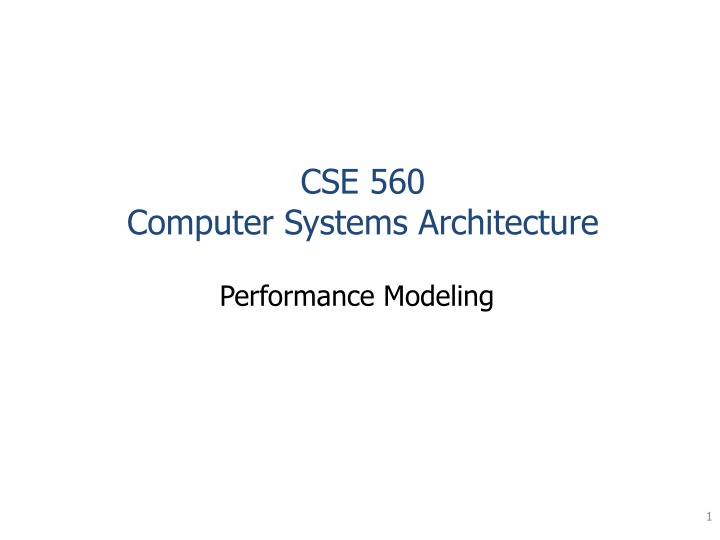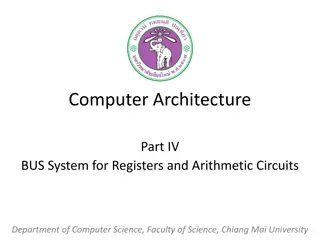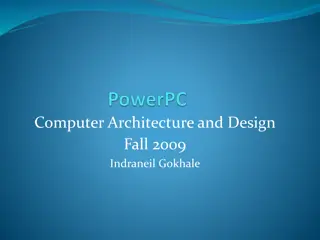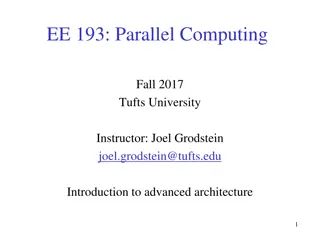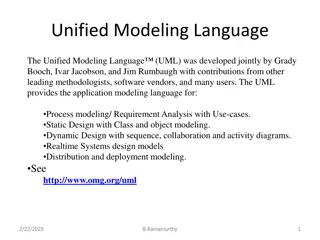Computer Systems Architecture Performance Modeling
An architectural simulator reproduces computing device behavior, aiding in faster software development, design space exploration, and validation pre-hardware availability. Functional vs. Behavioral Simulators differ in implementing instruction set architecture vs. microarchitecture. Simulator design emphasizes performance, flexibility, and detail to optimize design goals. Understanding parallel vs. sequential operations, simulator types range from software to hardware simulators.
Download Presentation

Please find below an Image/Link to download the presentation.
The content on the website is provided AS IS for your information and personal use only. It may not be sold, licensed, or shared on other websites without obtaining consent from the author.If you encounter any issues during the download, it is possible that the publisher has removed the file from their server.
You are allowed to download the files provided on this website for personal or commercial use, subject to the condition that they are used lawfully. All files are the property of their respective owners.
The content on the website is provided AS IS for your information and personal use only. It may not be sold, licensed, or shared on other websites without obtaining consent from the author.
E N D
Presentation Transcript
CSE 560 Computer Systems Architecture Performance Modeling 1
Computer Architecture Simulator Primer Q: What is an architectural simulator? A: tool that reproduces the behavior of a computing device System Outputs Device Simulator System Inputs System Metrics Why use a simulator? leverage faster, more flexible S/W development cycle permits more design space exploration facilitates validation before H/W becomes available level of abstraction can be throttled to design task can tell us quite a bit about performance 2
Functional vs. Behavioral Simulators Functional Simulators Implement instruction set architecture (what programmers see) Execute each instruction Takes real inputs, creates real outputs Behavioral simulators (also called Performance Simulators) Implement the microarchitecture (system internals) 5 stage pipeline Branch prediction Caches Go through the internal motions to estimate time (usually) Might not actually execute the program 3
The Zen of Simulator Design Performance Performance: speeds design cycle Flexibility: maximizes design scope Detail: minimizes risk Flexibility Detail Design goals will drive which aspects are optimized Previous versions of this class have used: SimpleScalar: optimizes performance and flexibility VHDL: optimizes detail This year we will use gem5 Cycle accurate chip multiprocessor Used lots of places! 4
Parallel vs. Sequential start here Hardware is parallel, software is not. 5 stage pipeline vs. our simulate() method Can t execute 5 stages in parallel, so traverse the pipeline backwards HW table = software array dm_cache[index].data, dm_cache[index].tag Anything more complicated? Serial approximation of parallel structure Accessing all 4 ways in a set at once? Nope. CAM lookup (find all entries with value X). Nope. Flush entire instruction window? Nope. Simulator is slower b/c it s in software and its serial 5
Simulator Types Software Simulators Processor Core Simulators Cache Simulators Full-system Simulators Hardware Simulators (VHDL, etc.) You instantiate every wire 3 Register read ports in SW vs. HW Less flexible More complex (and complete) model of real system Slower to develop Can use FPGAs for emulation (huge benefit for speed!) 6
Execution vs. Trace-Driven Simulation What is the input to the simulator? Trace-based Simulator (input = dynamic insns) Reads trace of insns captured from a previous execution Easiest to implement, no functional component needed Execution-driven Simulator (input = static insns) simulator runs the program, generating a trace on-the-fly more difficult to implement, but has many advantages direct-execution: instrumented program runs on host 7
gem5 Simulator Heritage GEMS M5 Processor Models Memory Models gem5 Authored in C++ and Python 8
Simulator Options Configuration File: Configure the system being modeled (e.g., ISA, size of cache line, in order vs. out of order execution) Specify the binary executable to simulate Control the simulation (start, stop, etc.) Literally is a Python file Anything available in Python is available here Python interpreter included in simulator! 9
Simulator Output Three output files: config.ini and config.json Lists every SimObject created and its parameters Indicates what did I actually simulate? Results of simulation in stats.txt file Dump of pretty much everything collected during simulation Command line option: -d DIR Specify directory for output files Overwrites output files if present 10
But where is CPI? CPI is not one of the statistics that is provided directly in the stats.txt file What if we want to know CPI? Definition of CPI is average cycles/instruction Simulator tells us cycles sim_ticks (almost! wrong units, however; also need clock period) Simulator tells us dynamic instructions sim_insts (don t confuse this with micro-operations, sim_ops) Divide In effect, we are using perf. eqn. to solve for CPI Simulation tick time is 1 picosecond 12
Simulation and Performance Equation Program runtime: seconds instructions cycles seconds program program instruction cycle x x = Instructions per program: simulator can tell us directly Including fractions of instruction types (e.g., %loads) Cycles per insn: CPI also can come from simulation Sometimes indirectly (e.g., output is CPI x tCLK) This is often a complex function of other things: Branch predictor Cache behavior Simulator can tell us model inputs (e.g., % predicted right) Seconds per cycle: clock period, tCLK simulator input 13
How to learn more about gem5 There is a great tutorial text: learning.gem5.org Tutorial talks available on youtube: www.youtube.com/watch?v=5UT41VsGTsg 14
Honesty is the Best Policy It is your job to design an honest simulator sim_cycle = sim_cycle/2 2x performance improvement! Woo hoo! Intel simulators have strict types Latched structures know about cycles throw error if you read more than n times per cycle What about cycle time? What can you accomplish in hardware? What can you accomplish in a cycle? 15
Sanity Checks You must convince yourself that your simulator is working If you cannot, you will never convince anyone else! Branch predictor gets 50% performance improvement? Initial stats showing the phenomenon you exploit How many branches are there? What does perfect branch prediction offer? What does a stupid branch predictor offer? Sensitivity studies showing how your idea changes across different values If you don t back up your results with secondary data, people will just think you re lying. 16
What about power? Static power charge each structure for length of run Cache leaks certain amount of power just sitting there Run for 200 ms, charge for that much leakage Dynamic power charge per use Read the cache 10,000 times in a run, charge for that What do we charge ? really hard to get right In fact, 0 1 different cost than 1 0 (yikes) Most academic power numbers are basically crap Squint. Trust the trends, not the numbers. 17
